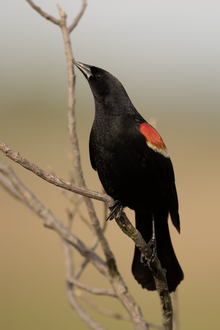| Red-winged blackbird Temporal range:
| |
|---|---|

| |
| Male in Ocean City, New Jersey | |

| |
| Female in Bluffer's Park, Toronto, Ontario | |
| Scientific classification | |
| Domain: | Eukaryota |
| Kingdom: | Animalia |
| Phylum: | Chordata |
| Class: | Aves |
| Order: | Passeriformes |
| Family: | Icteridae |
| Genus: | Agelaius |
| Species: | A. phoeniceus
|
| Binomial name | |
| Agelaius phoeniceus (Linnaeus, 1766)
| |
| Subspecies | |
|
A. p. aciculatus | |

| |
| Range of A. phoeniceus Breeding range Wintering range Year-round range
| |
| Synonyms | |
|
Oriolus phoeniceus Linnaeus, 1766 | |
The red-winged blackbird (Agelaius phoeniceus) is a passerine bird of the family Icteridae found in most of North America and much of Central America. It breeds from Alaska and Newfoundland south to Florida, the Gulf of Mexico, Mexico, and Guatemala, with isolated populations in western El Salvador, northwestern Honduras, and northwestern Costa Rica. It may winter as far north as Pennsylvania and British Columbia, but northern populations are generally migratory, moving south to Mexico and the Southern United States. Claims have been made that it is the most abundant living land bird in North America, as bird-counting censuses of wintering red-winged blackbirds sometimes show that loose flocks can number in excess of a million birds per flock and the full number of breeding pairs across North and Central America may exceed 250 million in peak years. It also ranks among the best-studied wild bird species in the world.[2][3][4][5][6] The red-winged blackbird is sexually dimorphic; the male is all black with a red shoulder and yellow wing bar, while the female is a nondescript dark brown. Seeds and insects make up the bulk of the red-winged blackbird's diet.
- ^ BirdLife International (2018). "Agelaius phoeniceus". IUCN Red List of Threatened Species. 2018: e.T22724191A132027891. doi:10.2305/IUCN.UK.2018-2.RLTS.T22724191A132027891.en. Retrieved November 11, 2021.
- ^ Yasukawa, Ken; Searcy, William A. (1995). A. Poole (ed.). "Red-winged Blackbird (Agelaius phoeniceus)". Birds of North America Online. Ithaca: Cornell Lab of Ornithology. Retrieved November 13, 2012.
- ^ McWilliams, Gerald M.; Brauning, Daniel W. (2000). The Birds of Pennsylvania. Ithaca, NY: Cornell University Press. ISBN 0801436435.
- ^ Richard Dolbeer (2008). "Blackbirds and their Biology". Internet Center for Wildlife Damage Management. Archived from the original on July 3, 2014. Retrieved April 16, 2013.
- ^ Beletsky, Les (1996). The Red-winged Blackbird: The Biology of a Strongly Polygynous Songbird. Academic Press. ISBN 978-0-12-084745-7.[page needed]
- ^ Holm, Celia Haigh (1973). "Breeding sex ratios, territoriality, and reproductive success in the red-winged blackbird (Agelaius phoeniceus)". Ecology. 54 (2): 356–65. Bibcode:1973Ecol...54..356H. doi:10.2307/1934343. JSTOR 1934343.
